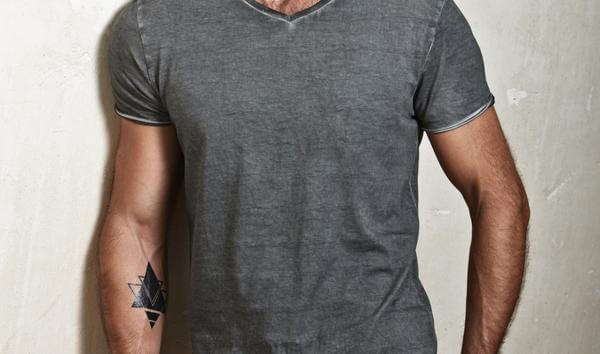PRINTING ON SYNTHETIC BLENDED FABRICS

KNOW YOUR SUBSTRATES
When printing on synthetics, like Heathers and Tri-Blends, it’s always best to avoid large, heavy areas of ink coverage and multi-color designs because they require multiple flashes and longer curing times, which promotes migration. A good way to determine how much a fabric might migrate is to do a migration test following instructions from your ink manufacturer. They should have a formal method to determine if the dye will migrate. It’s also a good practice to test print your garments prior to running production. After test printing, place the fabric or garment in a box in a warm area and let it sit for a few days to see if it migrates. Migration can happen immediately or can take up to a week to fully migrate.USE DYE BLOCKER INKS
There are a few different ink platforms to choose from: Low Bleed, High Poly and Low Cure inks. Choose the right one for your print project.
- Low Bleed: These inks are great for 50/50 blends where the fabric has a low synthetic content.
- High Poly: These inks are for 100% polyester fabrics to high poly content fabrics. Their viscosity is thicker and super opaque.
- Carbon base Grey/Black: These inks are used as an underbase to absorb the dye when it gases and reduces/blocks the dye from working through to the surface of the ink.
- Low Cure: These inks have a low blocking agent but they cure at 250-280 degrees and are great for Heathers, Tri-blends and substrates where you need to achieve a lot of detail and a great hand. Using these inks eliminates scorching and reduces heat and energy usage, which ultimately saves you time and money.
Quick Tips
Mesh Count: Using a 110-160 mesh will allow you the best coverage and opacity for your base screens. Your top inks should be 160-230 mesh. Your white overprint mesh should be 110-160.
Viscosity: Make sure you stir your ink prior to production to reduce the viscosity, which will help push the ink through the mesh to give you a better print surface.
Squeegee Pressure: Using light pressure is key. Keeping the ink on the surface of the fabric will help with opacity, hand and migration. If the fibers work up through the ink it will increase the chance of dye-migration. Plus, if you apply too much pressure it will push the ink through the fabric which is an undesirable feeling to the skin when worn.
Tapping/Smoothing Irons: Poly inks are thick and can be rough to the touch, and when printing on performance, Heathers and Tri- blend fabrics hand is just as important as reducing migration. So smoothing your ink surface will improve the quality of the prints as well as the feel. To do this, use a tapping/smoothing screen in your first station to help lay-down any loose fibers. Print your base screen and flash, but instead of a cool-down station add another tapping/smoothing screen to even out the ink. Then you can print your top color inks. It is recommended to use two white screens.
Screen Tension: Having the proper screen tension is key in keeping your ink on top of the fabric. Keep your screens tight and use a thin thread diameter. This will promote better lay-down without needing a lot of pressure, which will result in cleaner and tighter registration, and you can achieve a smoother surface with less mesh texture in your ink. If you have poor tension (too loose) in your screens you will have registration issues and will be forced to apply more pressure to get the ink through the screens. This will drive the ink through the fabric and allow fibers to work up to the surface of the ink, which causes dye-migration.
Flashing and Curing: Proper curing is the most important step when printing on poly fabrics. Be careful not to exceed curing temperatures. Migration occurs around 270° degrees Fahrenheit/97.2° degrees Celsius. Don’t over flash or over cure your garments. Use inks that have a quick flash point. Flashing should only be a few seconds and keep temperatures below 200° degrees Fahrenheit. Reduce the number of flashes in your design. If you don’t have to flash, then don’t. Use inks you can cure at a lower temperature (between 250° - 270° degrees Fahrenheit). You should also slow the dryer belt speed to help the ink cure at lower temperatures.
No Stacking: Use fans and long cooling stations on your dryers to help cool down the garments faster. Avoid stacking garments until they are completely cool. Pressure and heat can accelerate any migration.
Follow Manufacturer Guidelines: Not all inks and substrates are alike. So, always follow the ink manufacturer’s suggestions. However, if you still incur challenges, don’t hesitate to contact your ink supplier for advice. Many ink manufacturers will offer their expert advice and possibly travel to your shop to help with your printing issues and needs.
Screen Printing Spec Sheet:
Recommended for High Polyester Blend Fabrics
Station 1
- Tap/Smoothing Screen- Smooth out any fibers
Station 2
- Ink: PMS 286c Blue
- Mesh: 160(recommend thin diameter thread) Squeegee: 75/90/75
- Angle: 5° degrees Stroke: Single
- Pass/Med-Fast Stroke
Station 3
- Ink: Carbon base grey/black Underbase Mesh: 110 (recommend thin
- diameter thread) Squeegee: 65/90/65
- Angle: 15° degrees Stroke: Double Pass/Slow Stroke Speed
Station 4
- Flash – 93°C/200° F 2-3 seconds
Station 5
- Tap/Smoothing Iron
Station 6
- Ink: Low Cure White Base
- Mesh: 110 (recommend thin diameter
- thread) Squeegee: 65/90/65
- Angle: 15° degrees Stroke: Double Pass/Slow Stroke Speed
Station 7
- Flash – 93°C/200° F 2-3 seconds
Station 8
- Cool Down Station
Station 9
- Ink: Low Cure White Over Print Mesh: 160 (recommend thin diameter
- thread) Squeegee: 65/90/65 Angle: 5° degrees Stroke: Single/Med Stroke Speed